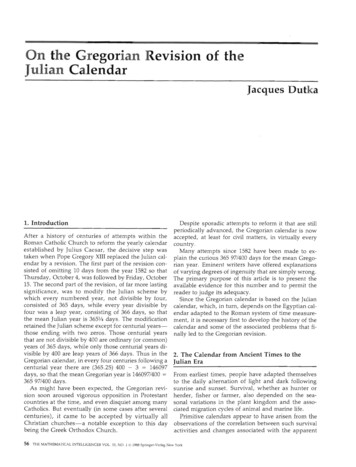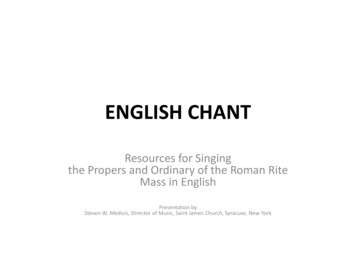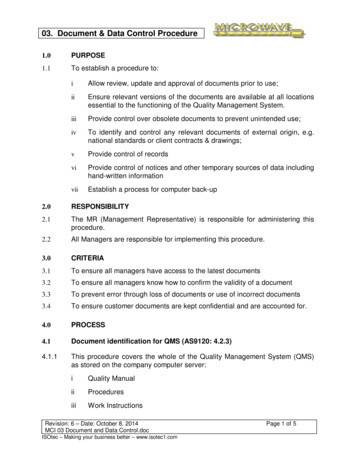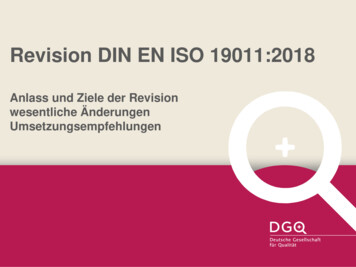
Transcription
On the Gregorian Revision of theJulian CalendarJacques Dutka1. IntroductionDespite sporadic attempts to reform it that are stillperiodically advanced, the Gregorian calendar is nowAfter a history of centuries of attempts within the accepted, at least for civil matters, in virtually everyRoman Catholic Church to reform the yearly calendar . country.established by Julius Caesar, the decisive step wasMany attempts since 1582 have been made to ex taken when Pope Gregory XIII replaced the Julian cal p lain the curious 365 97/400 days for the mean Grego endar by a revision. The first part of the revision con rian year. Eminent writers have offered explanationssisted of omitting 10 days from the year 1582 so that of varying degrees of ingenuity that are simply wrong.Thursday, October 4, was followed by Friday, October The primary purpose of this article is to present the15. The second part of the revision, of far more lasting available evidence for this number and to permit thesignificance, was to modify the Julian scheme by reader to judge its adequacy.which every numbered year, not divisible by four,Since the Gregorian calendar is based on the Julianconsisted of 365 days, while every year divisible by calendar, which, in turn, depends on the Egyptian cal four was a leap year, consisting of 366 days, so that endar adapted to the Roman system of time measure the mean Julian year is 365% days. The modification ment, it is necessary first to develop the history of theretained the Julian scheme except for centurial years calendar and some of the associated problems that fi those ending with two zeros. Those centurial years nally led to the Gregorian revision.that are not divisible by 400 are ordinary (or common)years of 365 days, while only those centurial years di visible by 400 are leap years of 366 days. Thus in the 2. The Calendar from Ancient Times to theGregorian calendar, in every four centuries following a Julian Eracenturial year there are (365.25) 400 - 3 146097days, so that the mean Gregorian year is 146097/400 From earliest times, people have adapted themselves365 97/400 days .to the daily alternation of light and dark followingAs might have been expected, the Gregorian revi sunrise and sunset. Survival, whether as hunter orsion soon aroused vigorous opposition in Protestant herder, fisher or farmer, also depended on the sea countries at the time, and even disquiet among many sonal variations in the plant kingdom and the asso Catholics. But eventually (in some cases after several ciated migration cycles of animal and marine life.centuries) , it came to be accepted by virtually allPrimitive calendars appear to have arisen from theChristian churches-a notable exception to this day observations of the correlation between such survivalbeing the Greek Orthodox Church.activities and changes associated with the apparent56THE MATH EMATICA L INTELLIGENCER VOL 10. NO . 1 " 1988 Springer-Verlag New Yo rk
motions of such celestial objects as the sun, moon, andstars. Indeed, on a small limestone tablet discoveredin 1908, now known as the Gezer calendar, which isinscribed in ancient Hebrew and is dated approxi mately 950 B. c., there is a description of a sequence ofagricultural activities associated with the successivemonths-lunar calendars are probably the most an cient. But the Greek writer Hesiod (app . eighth cen tury B.C.) in his Works and Days associates harvestingand seeding with the rising and setting of constella tions and stars. Similarly, sailors early learned to de rive navigational information from observations of ce lestial bodies.The need for some type of time reckoning, to deter mine the order of events or the intervals betweenthem, likely led to the development of more formaltypes of calendars, the rules for which would gener ally be prescribed by religious authorities. The earliestcelestial measures of time were associated with thedaily motion of the sun, the cycle of waxing andwaning of the moon, and the annual revolution of thesun relative to the fixed stars. A fundamental fact that the durations of the day, the month, and the yearare incommensurable-was likely recognized in pre historic times.The oldest Egyptian calendar was a lunar one of 12months consisting alternately of 29 and 30 days. Butby at least the fifth millenium B.C. it was replaced by acalendar of 12 months each consisting of 30 days. Eachday was divided into 24 " hours," 12 for daylight and12 for night, the duration of an hour thus varyingdaily. (Only later, in Hellenistic astronomical works,was the day divided into 24 uniform time periods. The60-minute hour and 60-second minute are Babylonianin origin.)To adjust the calendar, five days, the epagomenes,were added at the end of the 360-day year. The Egyp tians apparently recognized that this adjustment wasnot exact-the solar year was about 365Y4 days . In theremarkable trilingual Decree of Canopus by PtolemyIII Euergetes dated 238 B.C. (rediscovered in 1866), asixth epagomenal day was introduced every fourthyear. But this Alexandrian calendar was soon rejectedas "Greek" by the conservative Egyptians who did noteven accept its successor, the Julian calendar, untilwell into the Christian era . (In modern times the Alex andrian calendar survives in the calendars of theCoptic and Ethiopian Churches.)Julius Caesar became the Pontifex Maximus in Romein 63 B.C . Following his Egyptian military campaignsin 48-47 B.C., he returned to Rome accompanied bySosigenes, an Alexandrian astronomer. To resolve theproblems caused by the divergences between the ca lendrical months proclaimed by the pontifices and themonths in their normal sequence in the year, Caesar,with the advice of Sosigenes, made drastic changes inthe old 12 month Roman calendar which began inThe Gezer Calendar. Museum of the Ancient Orient, Is tanbul.March. The year 46 B.C. (the 708th after the foundingof Rome according to the old calendar), was extendedto 445 days - it was later termed "the year of confu sion." The calends of 45 B.C. fell on January 1 of thenew Julian calendar.The second change was the adoption of the meanlength of the year as 365 1/ 4 days, three successivecommon years of 365 days and the fourth year, a leapyear, of 366 days. The preexisting calendar was thusreplaced by a solar calendar. In 44 B.C. the fifth month,Quintilis, was renamed July. Caesar also redistributedthe lengths of the months within the year in a moreregular manner, except for February, which had 29days. His successor, in 8 B.C., had Sextilis extended byone day at the expense of February, and renamed Au gust. Other minor changes in the lengths of monthsfrom September to December were also made by Au gustus .The Julian calendar did not proceed according to theintended scheme. This was due to misinterpretationsby the pontifices concerning the intercalation of oneday every fourth year. The errors thus introducedwere finally compensated for, and by A.D. 8, the origi nally intended Julian calendar was in normal opera tion-to remain unchanged in Europe until the GreTHE MATHEMATICAL INTELLIGENCER VOL. 10, NO. I , 198857
gorian correction of 1582. The Julian calendar, withits subdivision according to the Roman month, wasalso used in the Near East and North Africa, indeedthroughout the Roman empire .The most detailed modern reference on the historyof ancient calendars in the Mediterranean area is thatof V. Grumel [11. An older but valuable work is thethree-volume treatise of F. K. Ginzel [2]. A good sum mary is given in the Explanatory Supplement to theAstronomical Ephemeris [3; Ch. 14J, which is based onearlier work by the British scholar J. K. Fotheringham.Additional references on special topics will be foundin these works . Finally, the monumental treatise ofO. Neugebauer [4] , the dean of historians of ancientscience and mathematics, is replete with historical,mathematical, and astronomical detail not available inany other single source .3. The Controversy over the Date of EasterEaster is the most important holiday in the Christianecclesiastical calendar, and the dete.rmination of thedate of Easter is significant not only for this reason butbecause the dates of the movable holidays are depen dent on it. The formulation of a better set of rules forits annual celebration was the principal motivation forthe Gregorian revision of the Julian calendar.The earliest Christians, who had been born Jews,continued to observe the Jewish Passover, but gave atransfigured symbolic meaning to the traditional sacri fice of the Paschal lamb. As Christianity gained Gen tile adherents, there was increaSing agitation withinthe Christian communities to distance their religiousobservance of Easter from the Jewish celebration ofPassover. By about A. D . 150 bitter controversies in creased between Western Christian communitiesbased in Rome and Alexandria, who celebrated Easteron a Sunday , and those who followed the Jewishpractice of observing Passover beginning with the eve ning of the 14th day of the lunar month of Nisan .(About the fourth century B.C. , following their returnfrom the Babylonian exile, the Jews adopted the laterform of the Babylonian calendar with the same 19-yearcycle as had been introduced by the astronomer Ci denas in 383 B.C. This cycle consists of 12 ordinary orregular years of 12 lunar months and 7 leap years of 13lunar months in which a year begins with the au tumnal month of Tishri. This calendar replaced theprevious calendar, mentioned in Exodus, whose firstmonth, Abib, corresponded to the spring month ofNisan.)Numerous ecclesiastical assemblies failed to settlethe Easter question until Constantine made Chris tianity the state religion and convened the Council ofNicaea (in Bythnia) in A. D . 325 . The Council wascharged with settling the Arian schism and the Easter58THE M ATHEMATICA L INTELLlGENCER VO L. lO, NO . l , 1988question. In its epistle to the Church of Alexandria,the Council expressed its approval of the practice ofthe Romans who observed Easter on a Sunday andhenceforth enjoined all Christians to do so on thesame day. It also requested the Alexandrian church,whose mathematical and astronomical skills it praised,to compute yearly the date of Easter and to communi cate this to other Christian churches. The Church ofAlexandria complied, but its directions were not ac cepted by Eastern churches, which follow their owncustoms to this day. Many Western churches in themore remote parts of the Roman Empire clung tena ciously to local customs for determining Easter forcenturies.By about t0e sixth century the practice was estab lished among those who followed the doctrine of theRoman church of a fi xed rule : Easter is the firstSunday after the first full moon occurring on or nextafter the vernal equinox . This was based on a Julian(solar) calendar for the date of the vernal equinox anda (lunar) calendar with a 19-year cycle, the Metoniccycle, for the determination of the date of the fullmoon . (In 432 B.C. , Meton of Athens introduced acycle in which the dates of the new moons repeatevery 19 years .)At this point some astronomical definitions andconstants will be useful. The tropical (mean solar) yearis the interval between two successive passages of themean sun through the mean vernal equinox and isabout 365.2422 (mean solar) days . (It varies slowlyover time.) The synodic month is the interval betweentwo successive new moons (conjunctions), the latteroccurring when the (geocentric) longitudes of the sunand moon on the celestial sphere are equal, and isabout 29 .53059 (mean solar) days.P.Apparent motion of the sun on the celestial sphere .
Let a and b denote the number of 365- and 366-dayyears such that1 tropical year b365.2422 days 365a 366b 365 a ba bThus, expressing b/(a b) as a simple continued frac tion, one gets1111111.2422 - - - - - 4 7 1 3 4 1 F/3with the first six convergents1 7 8 31 132 16329 ' 33' 28' 545' 6734'expressed in decimals and rounded off as .25, .24135,.24242, .24219, .24220 , .24220- , and alternately inexcess and defect. The first of these is the Julian inter calation, and the third is that suggested by the Persianastronomer, mathematician, and poet, Omar Khay yam, in about A.D. 1079. It is a more accurate approxi mation of the tropical year than the Gregorian cal endar with the approximation 97/400 .2425 . Theproblem facing the Calendrical Commission ofGregory XIII, however, included constraints imposedby lunar and solar calendars, as well as those imposedby religious traditions, custom, and usage . The com promise actually adopted, described in Section 1, hasmany conveniences .The ratio of the tropical year to the synodic month,expressed as a continued fraction, is365.242229.530591 1 1 1 11- -- - - - - - .12 2 1 2 1 1 17 with the convergents12 25 37 99 136 235 4131334 'l ' 2 ' 3' 8' 11' 19'Such approximations were extensively investigatedby astronomers of antiquity . The fourth is associatedwith Cleostratus and the sixth with Meton andCidenas in Greece and Babylon . The Metonic cycle isone of the outstanding achievements of ancient as tronomy. It may be interpreted as equating 235 luna tions ( 6939.69 days) to about 19 Julian years( 19· (365.25) 6939 .75 days), the error involvedbeing about 1.48 hours.W-e do not know how this remarkable approxima tion of 235119 to the ratio of the tropical year to thesynodic month was obtained. A. Pannekoek [5; 5lff.],an astronomer of the Netherlands, suggested that itarose from a long series of Babylonian observations.Others have suggested that ancient astronomers mayhave employed numerical algorithms now lost, likecontinued fractions , to obtain close approximations toratios with large numerators and d enominators bymeans of simpler fractions with much smaller numer ators and denominators . Perhaps the most remarkableexamples of this type in the West occur in a treatise ofAristarchus of Samos, who was active about 280-264B.C. and maintained a heliocentric theory of the uni verse and the rotation of the earth on its axis . In thistreatise, On the Sizes and Distances of the Sun and theMoon , he obtains grossly inaccurate results, but hismethodology is mathematicall y valid . In his Proposi tion 13, Aristarchus states that 7921/4050 is greaterthan 88/45 . The latter ratio is the fourth convergent inthe continued fraction expansion of the former. In hisProposition 15, Aristarchus states that 7 1755875161735500 is greater than 43/37. The latter ratio is thethird convergent in the continued fraction expansionof the former. (On this question see 1. Thomas [6; Vol.II, 14-15] and O. Neugebauer [4; Part 2, 641f .], whopresent contrasting views.)An enormous literature exists in virtually everymodern European and many non-European languageson questions concerning Easter. In addition to thegeneral references on chronology and the calendarmentioned at the end of Section 2, an excellent discus sion in English of the controversies associated withEaster is in C. W. Jones [7], which is updated by R. R.N ewton [8; Ch. II] .4. Prehistory of the Gregorian RevisionThe two premises on which the ecclesiastical calendarof the Roman church had been based before the Gre gorian revision, the Julian year length and the Metoniccycle of 235 lunations in 19 Julian years, were onl y ap proximations to the actual celestial phenomena. TheJulian year errs in excess by .0078 per year; the synodicmonth obtained from the Metonic cycle is in excess byabout .000255 per month. Within a few centuries afterthe Council of Nicaea, it was observed that the vernalequinox was occurring earlier each year than the nom inal date of March 21 associated with the year A . D.325. (According to Ginzel [2; Vol. 3, 257], the meansolar time of the vernal equinox at Rome in 325 was at12h 44m on March 20; Newton [8; 24-25] gives a rangeof 3h to about 21h on March 20 for the years around325 .) By the thirteenth century, the error was seven oreight days . These divergences were recognized by theRoman church, but because of external and internalcircumstances, no calendrical revisions were made de spite numerous plans for reformation . The publicationof the Alfonsine Tables under the sponsorship of Al fonso X of Castile (begun much earlier but finally com pleted c. 1272), incorporating Arabic and contempo rary observations, gave a much better foundation formedieval astronomy in Europe than had heretoforeTHE MATH EMATI CAl.I NT ELLI GEN CER VOL. 10. NO. I , 198859
existed, and it became the standard astronomical workfor centuries,(Alfonso himself, on being given an explanation ofthe Ptolemaic system as set forth in the Almagest, issaid to have remarked that if God had asked his ad vice, he would have made the universe less compli cated.)The first edition of the Tables was printed at Venicein 1483, and subsequently it went through many edi tions. (An interesting description of the circumstancesof composition, the contents, the various editions, andthe men involved was given by the Danish astronomerJ. L. E. Dreyer [9].) In particular, according to the Al fonsine Tables, the tropical year is 36Sd Sh 49m 16s,some 10m 44s shorter than the 36Sd 6h of the Julianyear. The value for the tropical year of 36S.2422d isequal to 365d 5h 48m 46s, so the Alfonsine year errs inexcess by 30 seconds per year. The value finallyadopted for the (present) Gregorian calendar is 36597/400d 365d 5h 49m 12s, which is 26 seconds inexcess per year.The French cardinal, Pierre d' Ailly, proposed at acouncil in Rome in 1412 that one leap year in 134 Julianyears be replaced by an ordinary or common year of365d (and every 304 years one day be omitted from the19-year moon cycle.} This proposal regarding theyearly correction appears to have been later acceptedby the German cardinal Niclaus von Cusa, who more over suggested the one-time elimination of seven daysfrom the calendar (for the end of May 1439), whichwould have brought the solar and lunar years intoconsonance.These proposals for calendrical changes did notprove fruitful until about the 1560s. Petrus Pitatus ofVerona wrote a number of works on the calendar andmade detailed suggestions for calendrical revision(see, e.g., Pitatus [10D, In these works, he acceptedthe Alfonsine year, but he approximated the proposalof d' Ailly by replacing it by a far simpler and moreconvenient suggestion for the omission of three leapyears in every 400-year cycle113134133V3400Moreover, he proposed that the omissions occur incenturial years. Since 1500 had been a leap year in the(Julian) calendar, he proposed that 1600, 1700, and1800 be common years, but that 1900 be a leap year this is, except for the starting point of the centurialleap-year omissions, identical to the plan of the Grego rian calendar that was later proposed by AloysiusLilius.The principal architect of the Gregorian calendarwas a physician and lecturer at the University of Pe rugia, Aloysius Ulius (Lilio, Giglio) of Calabria (1510? 1576). Few details concerning his life are known, butG. Aromolo [11] wrote a biography that summarizes60.THE MATHEMATICAL INTELLIGENCER VOL. 10, NO. 1, 1988/ , ", Aloysius Lilius. (From an engraving printed in Naples.)the history of calendrical reform efforts and of thework of Lilius, who migrated to northern Italy afterbecoming a physician.After the death of Lilius, his brother and (partial)collaborator, Antonius , a personal physician ofGregory XIII, in 1577 presented Aloysius's manuscriptto a commission appointed by Gregory XIII to considerthe reformation of the calendar. (Gregory XIII, UgoBuoncompagni of Bologna, had been elected Pope in1572 at age 70 and died in 1585. A history of his pa pacy was written by L. von Pastor [12]. A nineteenth century descendant of the family, Prince B. Boncom pagni of Rome, was the publisher of the Bulletino di.Bibliagrafia di Staria delle Scienze Matematiche e Fisiche,and a patron of continental writers on the history ofmathematics.) After some delays, a summary of themanuscript was prepared by an astronomer, PedronusChaconus of Toledo, perhaps initially for the use ofthe Calendrical Commission. The summary, Compen dium [13}, was reprinted in the works of ChristophClavius [14; 3-12] in 1603 and 1612. Copies of thesummary were sent by the order of Gregory to Cath olic princes and universities in early 1578 to obtainsupport f01' the projected reform and invite comments .(Copies of the original Compendium were found a few
years ago by Gordon Moyer and Th. B. Settle in Italian endar, it was decided to omit 10 days in October andlibraries in Florence, Rome, and Siena.) A number of thenceforth three leap years in 400, as had been pro comments and suggestions, some contradictory, were posed. After further delay, the Papal Bull, Inter Gravis received and evaluated by the Commission.simas, was issued dated February 24, 1581 /2 (repro After much internal discussion of many different duced by Clavius [14]) and was accompanied by a setviews, the Commission settled on the plan originally of rules, the Canones in Kalendarium Gregorianum per suggested by Lilius, with some modifications. The petuum, which is the present ecclesiastical calendar ofCommission had been charged with two basic tasks: to the Roman church . No officially sanctioned explana determine a method for computing the date of Easter, tion of the new calendar was made until the appear and to stabilize the vernal equinoctial drift in the cal ance of the massive tome of Clavius in 1603 (repro endar. An implicit assumption was that such changes duced in Clavius [14]). It was based on an earlier workas would be made would be in accord with the reli of Clavius [16] of 1588, which was a reply to the attackgious traditions and customs of the Roman church. of Michael Maestlin on the new calendar.In the litera ture, the influence of Nicolaus Coper Moreover, as the Jesuit Christoph Clavius of Bambergwas later to emphasize in his reply to the objections to nicus on the final form of the Gregorian revision is fre quently discussed. Pitatus [10] does mention Coper the Gregorian calendar by Michael Maestlin of Tii bingen, a teacher of Johann Kepler, the rules for the nicus, but only in the sense that some observations ofCopernicus and others confirm his own choice of thecalendar finally adopted had to be convenie'nt and rea sonably simple-accordance to (existing) astronomical Alfonsine Tables for his basic astronomical data. In theCompendium [15], there is no mention of Copernicusinformation was secondary.For the calendar, Lilius suggested a plan equivalent -only the Alfonsine year length is mentioned as ato that previously put forward by Pitatus, also basedon the Alfonsine year. While Pitatus had left open thequestion of the da tes of the vernal and autumnalequinoxes, Lilius suggested March 21 for the date ofthe vernal equinox-(nominally) that of the Council ofNicaea in 325-and offered two alternatives to com pensate for the equinoctial drift. One of these-theomission of 10 days in a single year-was accepted.This, and the change in the Julian four-year cycle ofX 11 I. ·leap years to a modification of the Pitatus's scheme sothat the 400-year cycle would begin with 1600 as a leapyear, constitute the (present) Gregorian calendar.Lilius's innovation was in the revision of the.method of computing new moons so that the lunar. . ! :ter. gr-aYiffi"m·a.s'Pafioraljs officii uoftricalendar agreed more closely with the proposed solar . curas ea poftr.cma nOllefi, utqU acalendar. This was the use of the epact, the age of themoon (in days) on January I, reckoned from the last. . '"S:l{:to' Trid'el tino COllcllio Sedi ApOl1oflcrt:new moon of the preceding year; see Kaltenbrunner. .r r" ata' furit. 'iilaad fiDem optaturn ,Deo .[15; (I), 490ff]. This linked the two calendars and en . 4(i l utor , 'per 1nCantllr ' .abled the date of the last full moon preceding Easter of§. J . Sa 'eejurdem ConciEi Patrc5 , cumthe current year to be computed. Tables of epacts to . . " ,ad reUguap1 c girariollem, Breviariiquo- .cover the 30 possible ages of the moon on January 1 . guc seura,m .adlUngcreot, tempore ramenwere included in the Compendium [13], as was a con :;){d ui'i , tcrn rotam ex ipJius Conci Iii de cordance, in tabular form, between the epact and the C(ctri;id auftgritatem ,&JudiciumRo.l11Cl. " Golden Numbers" previously used in the 19-year ', 1ii Pontl Bd5:rettderum cycle (equal to [year/19I 1). (One explanation of this""."."!:' - § z 1)uoautem Brev iario !)i.l:ciplle con name is that in illuminated medieval manuscripts. 'Jihenttll\" .quorum un \ 'prccc i;\Udd{lutthese numbers were frequently written with gold ink.): . i{ijvlf1as:f ft:jsPi.'q· feftifqile di bus ptrfo!veu-'.An extended table of epacts in the form finallyadopted by the Commission was given by Clavius [14; . ilascompreetjtUl·".,att. rum; pertj.net 'ad an-.t". . ;hl!os .f'afchte " fefton:;IUJ1Ue excv, pendelL 110-111].: .ifit (SolJ"s., '&.:ltu9 mot-u mr;;ti eiidos. . . The Commission finally issued a report to the Pope. lAtq,lle jUnci :qllj9 m f:.1. . ec 'p'ij V; .(Cod. Vatic. 3685) (which was later printed in Kalten c'lfo; 'abl()lv,·e i1d\lll1'. i:m' vit ,; ; brunner [15; (3), 48-54]), about the beginning of 158l.'} gl ';! :." ":' . :': ' :. ' . The plan that Lilius had proposed was approved in asomewhat modified form. In regard to the Julian cal The Papal Bull of 1582 proclaiming the new calendar. . THE MATHEMAT1CAllNTELl.lGENCER VO l. 10, NO . 1, 198861
Medallion of Gregory XIIIcommemorating the restoredcalendar. Obverse: Alikeness of Gregory XIII.Reverse: A ram's head-theconstellation Aries, adornedwith a garland, denotingspring, encircled by aserpent biting its tail,denoting a cycle, with amotto.(obverse)mean among several, as having lesser error. Finally,and most important of all the evidence before 1582, isthe official report of the Calendrical Commission (ofwhich Clavius was the most active member); see Kal tenbrunner [15; 52-54). The report states that as ofSeptember 8, 1580, the Commission had reached aconsensus to the effect that the Alfonsine year value,taken as 365d 5h 49m, etc., was assumed to be be tween the maximum and minimum, so that the vernalequinox is anticipated (in the calendar) by one day inabout 134 years, which becomes three days in 400years. In regard to the lunar-calendar aspect of Lilius'soriginal plan, Clavius [14) [16) states that the Pruden tine Tables (of Erasmus Reinhold, a disciple of Coper nicus) were used in preference to the Alfonsine Tables.As mentioned in Section 1, after the introduction ofthe new calendar, considerable partisan controversyconcerning it arose. It lasted in some countries forcentur,ies, but is now principally only of historical in terest. People gradually came to accept that the Grego rian calendar was much more accurate, and thus ulti mately more useful, than the Julian calendar it had re placed. The error in the Gregorian calender is less thanone day in 3000 years, and Vatican astronomers, suchas J. de Fort [17), occasionally reexamine the questionin the light of more recent astronomical information,SlKh as the slowing down of the earth's rotational rateby about Y2 second per century.After the elapse of more than a century, the studiesof F. Kaltenbrunner [15) on the history of the Grego rian calendar remain the most extensive. They weresupplemented and corrected in some detail by J.Schmid [18], J. G. Hagen [19), and others. Especiallyto be noticed is a commemorative volume recentlypublished (G. V. Coyne, et aI., eds. [20)) after the400th anniversary of the Gregorian calendar.Many articles and books on the Gregorian calendarare to be found in the literature, old and new. Thewriter has found the technical monograph (in Dutch)of W. E. van Wijk [21], with its illustrations, tables,and bibliography, particularly interesting.62THE MATHEMATICAL INTELLlGENCER VOl. 10, NO.1, 1988(reverse)S. The Misapplications of Continued FractionsRaffaele Bombelli of Bologna is generalLy credited withhaving been the first European in modern times to in troduce, in the first edition of his book on algebra of1572, a particular type of continued fraction that wasapplied to the extraction of square roots . His work wasimproved upon in the seventeenth century, and sim ple continued fractions were introduced indepen dently by various writers. But the practical develop ment of this algorithm, in relatively modern form, oc curred in the eighteenth century with the posthumouspublication of a work of C. Huygens, and particularlywith the far-reaching developments of L. Euler inmany books and memoirs. For a brief summary of theearly history, see D. J. Struik (ed.) [22; 111).Euler was the most prolific and surely one of thegreat mathematicians of all time. Yet, as others havepOinted out, in matters relating to the history of math ematics, he is often unreliable.Euler [23; 390) takes as the length of the tropical year365d 5h 48m 55s and proceeds to convert the fractionalpart of the day into seconds. Then he obtains a con tinued fraction expansion of 20935/86400 with the con vergents:o1l' 4'7 8 55 63 18129' 33' 227' 260' 747'He says that from the first and second, the Julian cal endar arises. More exact is 8 days in 33 years or 181days in 747 years; "whence there follows in fourhundred years 97 days. Whereby in this interval theJulian calendar inserts 100 days, the Gregorian con verts three leap years into common [years) in fourcenturies." Euler lacks his customary clarity in theconclusion!J. L. L. Lagrange, a younger contemporary andfriend of Euler, was among the greatest mathemati cians and astronomers of the eighteenth century andjustly esteemed for the quality of his writing. He gave
an exemplary presentation, from a mathematicalstandpoint, of the application of continued fractions toproblems of diophantine analysis that is still worthreading. He is less careful, however, when it comes tohistori
THE MATHEMATICAL INTELLIGENCER VOL. 10, NO. I, 1988 . 57 . gorian correction of 1582. The Julian calendar, with its subdivision according to the Roman month, was also used in the Near East and North Africa, indeed throughout the Roman empire. The most detailed modern reference on the hist










